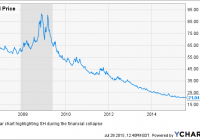It Is Not Possible That Valuations Matter Only At The Margins
By Rob Bennett You will often hear people say that valuations matter only at the margins. That is, valuations matter when prices are very high and when they are very low. Outside of that, it is okay to ignore the effect of valuations. I see this as dangerous thinking. My view is that either valuations matter or they do not. If they matter, they always matter. If they don’t matter, they never do. I am not able to make sense of the idea that valuations matter in some circumstances, but not in others. The first point that needs to be made is that there is a practical sense in which the claim that valuations only matter at the margins is true. Stocks generally offer a significantly better long-term value proposition than other asset classes. So, when stocks are priced at only a bit more than their fair value price, they remain a good investing choice. In a practical sense, then, a high stock allocation makes sense until the overvaluation reaches such a point that the mispricing is extreme. The problem is that there is no one valuation level at which stocks are transformed from a good choice to a bad one. Stocks are a little less appealing when the P/E10 level is 18 than they are when the P/E10 level is 15. And they are, of course, even less appealing when the P/E10 level is 21. And then even less appealing when the P/E10 level is 24. And even less appealing when the P/E10 level is 27. What is the investor to do? When does he lower his stock allocation, and by how much? It’s tricky. Stocks became a bit less appealing when the P/E10 level rose from 15 to 18, and then again when it moved from 18 to 21, and from 21 to 24, and from 24 to 27. But as the PE10 level moved from 15 to 27, the feedback being received by the investor was all positive. The risk of owning stocks was becoming greater. The investor should have been lowering his stock allocation in an effort to keep his risk profile constant. But at the moment when the P/E10 value reached the insane level of 27, the investor who failed to lower his stock allocation as the P/E10 value moved to 18, and then to 21, and then to 24, and then to 27 was feeling good about those decisions. So he was left disinclined to changing it much, even when prices had gone to “the margins” of 27 and above. What Jack Bogle says about this is that investors should not change their stock allocations in response to price increases. But if they feel that they absolutely must change their allocation at the margins, they should not lower them by more than 15 percent. Bogle has never explained how he came up with the 15 percent figure. I use the historical return data as my guide. The data shows that stocks are likely to offer an amazing long-term return when prices are at low levels or at fair value levels, and then the long-term return drops and drops as prices continue to rise. The data shows that most investors should have been going with a stock allocation of about 80 percent in the early 1990s and about 20 percent in the late 1990s and early 2000s. That’s a change not of 15 percentage points, but of 60 percentage points. Bogle’s recommendation is off by 400 percent, according to the 145 years of historical data available to us today. How many people know that? People don’t know how dangerous it is to own stocks when they are selling at high valuation levels, because most advisors buy into the idea that valuations matter only at the margins. If you only consider valuations at the margins, you are missing out on most of the story of how the mispricing of stocks derails investor retirement plans. Stocks don’t suddenly become dangerous when the P/E10 value hits 27. They are virtually risk-free when the P/E10 value is 15. Then, they become more risky at 18. And more risky at 21. And more risky at 24. And more risky at 27. Unfortunately, the growing risk is a silent one. Stocks are far more risky when the P/E10 value is 21 than they are when it is 15. But years can go by before that risk evidences itself in portfolio destruction. Valuation risk plays out the way that cancer risk plays out for people who smoke three packs of cigarettes each day. Heavy smokers often “get away” with their behavior for decades before they contract a disease that kills them. However, the deep reality is different from the surface one. Someone who smokes three packs of cigarettes each day from age 16 to age 66 and then dies at age 67 from lung cancer was not avoiding the risk of smoking for 50 years; he was avoiding only the practical consequences of taking on a risk that would one day cause him to pay a terrible price. Disclosure: None.
